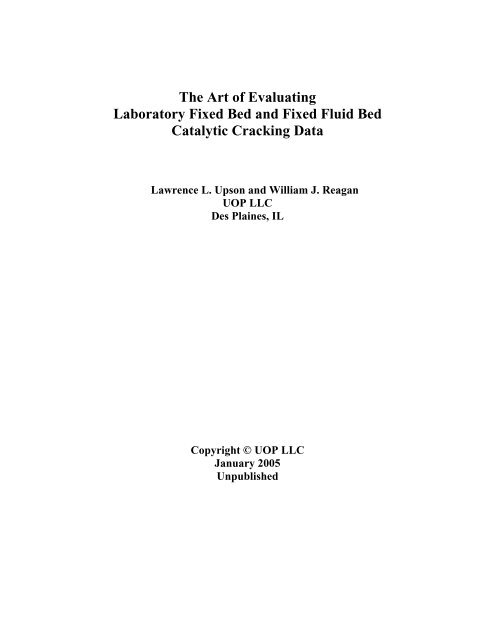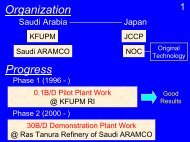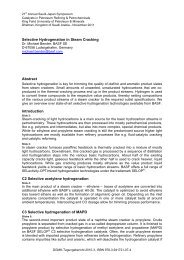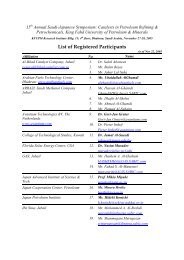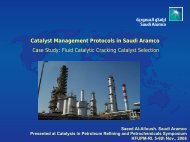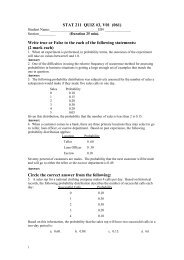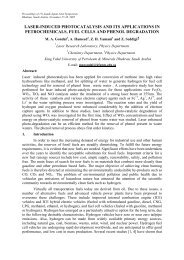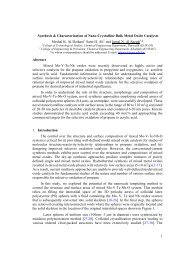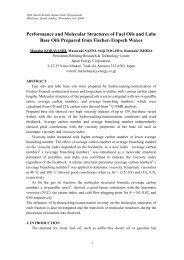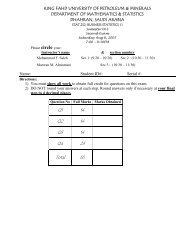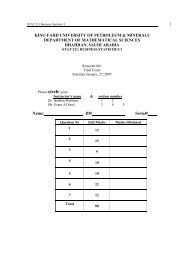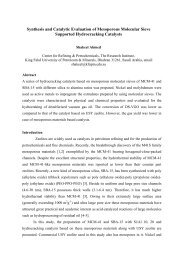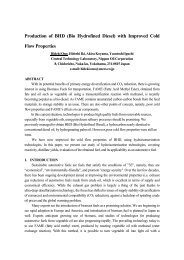The Art of Evaluating Laboratory Fixed Bed Catalytic Cracking Data
The Art of Evaluating Laboratory Fixed Bed Catalytic Cracking Data
The Art of Evaluating Laboratory Fixed Bed Catalytic Cracking Data
Create successful ePaper yourself
Turn your PDF publications into a flip-book with our unique Google optimized e-Paper software.
<strong>The</strong> <strong>Art</strong> <strong>of</strong> <strong>Evaluating</strong><strong>Laboratory</strong> <strong>Fixed</strong> <strong>Bed</strong> and <strong>Fixed</strong> Fluid <strong>Bed</strong><strong>Catalytic</strong> <strong>Cracking</strong> <strong>Data</strong>Lawrence L. Upson and William J. ReaganUOP LLCDes Plaines, ILCopyright © UOP LLCJanuary 2005Unpublished
<strong>The</strong> <strong>Art</strong> <strong>of</strong> <strong>Evaluating</strong> <strong>Laboratory</strong> <strong>Fixed</strong> <strong>Bed</strong> and <strong>Fixed</strong> Fluid <strong>Bed</strong> <strong>Catalytic</strong><strong>Cracking</strong> <strong>Data</strong>Introduction<strong>The</strong> Fluid <strong>Catalytic</strong> <strong>Cracking</strong> (FCC) community has used small, laboratory fixed bed units formany years to evaluate catalytic cracking results. Such units are typically used to evaluate thedifferences in the performance <strong>of</strong> various cracking catalysts and also are used to provide some insightinto the effect <strong>of</strong> process variables and feedstock effects.One such laboratory unit, which was used extensively in the later part <strong>of</strong> the twentieth century,was the Microactivity Test unit (MAT) (1). <strong>The</strong> test, as first described by Ciapetta et al (2) in 1967,consisted <strong>of</strong> a small bed (5 gms) <strong>of</strong> 3/32 inch pellets through which a small amount <strong>of</strong> feed (~1 cc) wasinjected downflow. <strong>The</strong> test was quickly modified (3) to allow evaluation <strong>of</strong> catalysts in the fluidcatalyst form, to improve mass transfer and heat transfer effects.More recently, a small fixed fluid bed unit utilizing essentially the same quantities <strong>of</strong> fluidcracking catalyst and FCC feed has been developed and is licensed by Kayser Technology Inc. <strong>The</strong> unit,designated as the Advanced <strong>Cracking</strong> Evaluation (ACE) Technology unit, has better heat and masstransfer characteristics than the MAT unit and has been gradually replacing MAT units since 1997 (4).Since both the ACE test and the MAT test utilize a fixed bed <strong>of</strong> catalyst, there are significantdifferences between the cracking environment in these tests and the environment in a riser reactor, astypically used in a commercial Fluid <strong>Catalytic</strong> <strong>Cracking</strong> Unit (FCCU). Nevertheless, the laboratory testresults from these units provide very useful information, and provide it in a cost effective manner. Both<strong>of</strong> these units provide data that allows for a comparison <strong>of</strong> the cracking activity <strong>of</strong> the various crackingcatalysts <strong>of</strong> interest and also a comparison <strong>of</strong> the product selectivity <strong>of</strong> the various catalysts.Such tests are usually run at a temperature chosen to simulate a particular commercial operation.<strong>The</strong> catalyst / oil weight ratio (C/O) is varied at either 1) constant on-stream time (t) by varying feedrate, or 2) by varying on-stream time at constant feed rate, hence constant weight hourly space velocity(WHSV). Either technique provides a range <strong>of</strong> conversions and hence a range <strong>of</strong> product yields. In thesetests, the three variables time, C/O, and WHSV are related as:t = 3600( C / O)(WHSV )t in secondsFrequently, in these tests, only a small number <strong>of</strong> C/O variations are used (3-5) and hence only asmall number <strong>of</strong> data points are available to develop the required conversion and product yieldcorrelations. In addition, a considerable amount <strong>of</strong> experimental error is associated with each set <strong>of</strong> data,making the proper correlation even more problematic.It is the purpose <strong>of</strong> this paper to describe practical techniques that can be applied to the handling<strong>of</strong> these types <strong>of</strong> laboratory data to obtain the maximum amount <strong>of</strong> reliable information.
Experimental<strong>The</strong> data used in this paper to discuss these techniques were obtained via ACE unit testing. <strong>The</strong>ACE unit was operated at the following run conditions:Reaction initial temperature 543ºC (1010ºF)Reaction time60 seconds <strong>of</strong> feedFeed rate1.30 grams / minuteCatalyst weightvariable to give ~ 3, 4, & 6 C/O<strong>The</strong> feed stock was a mid-continent gas oil with the following properties:Density0.9064 gms/ccUOP K 11.8Sufur5300 ppmwTotal nitrogen1340 ppmConradson Carbon 0.415 wt%ASTM D2887H (Sim Dist) ºCIBP 23610% 35350% 44090% 534EP 572<strong>The</strong> product was collected in a water displacement receiver and analyzed with an on-line gaschromatograph. <strong>The</strong> liquid product was collected in a chilled glass receiver. <strong>The</strong> boiling pointdistribution <strong>of</strong> the products was determined by standard simulated distillation GC procedures, ASTM2887. Coke on catalyst was determined by in-situ air calcination <strong>of</strong> the spent catalyst and measurement<strong>of</strong> product carbon dioxide with an infrared analyzer. Mass balances were calculated and only runs withbalances >95 wt% were accepted for the data correlations. Product yields were expressed on a weightpercent <strong>of</strong> feed basis.<strong>The</strong> three FCC catalysts evaluated for this paper were blends <strong>of</strong> a base equilibrium catalyst andvarious laboratory deactivated shape selective zeolite additives. <strong>The</strong> additives were deactivated in acyclic deactivation unit using 50 cycles <strong>of</strong> cracking over a gas oil feed at 565ºC (1050ºF) and air/steamregeneration at 788ºC (1450ºF).Correlating Conversion <strong>Data</strong>In small scale laboratory FCC testing at a constant reactor initial bed temperature, tests arefrequently carried out by varying C/O ratio, thus achieving a range <strong>of</strong> conversions. As in all laboratorytesting, experimental error exists resulting in considerable data scatter. <strong>The</strong> question is – What is the bestway to correlate the data to get the most accurate understanding <strong>of</strong> the effect <strong>of</strong> C/O ratio on conversion?It is tempting, in this age <strong>of</strong> computer developed technology, to let the computer determine thebest statistical fit to the data. This however is generally not the best approach. In many cases, only 3-4data points are available to develop the correlation since only 3-4 C/O ratios were evaluated, andfrequently replicate runs are not made. With the experimental error that exists, the statistical fit cangenerate nonsensical lines. If several catalysts are being tested with a single feed, the computer-
generated C/O versus conversion lines will typically cross each other at curious angles, a highly unlikelysituation.It is always useful, in developing correlations, to have one point which is known to have little orno experimental error, and, through which, the correlation can be forced. In the case <strong>of</strong> the relationshipbetween conversion and C/O, the conversion at zero C/O is fairly well defined. At zero C/O, theconversion might be expected to be 0.0 wt%. <strong>The</strong>re is, however, some conversion at essentially zeroC/O caused by the nearly instantaneous thermal cracking that occurs when the feed contacts the hotcatalyst environment. When the feed is constant, the thermal cracking at zero C/O would be constant forall the catalysts. Thus the conversion at zero C/O represents an anchor point through which all the plotsmust pass. <strong>The</strong> conversion at zero C/O is in the range <strong>of</strong> 25 wt% for most feeds, when the initial reactiontemperature is in the range <strong>of</strong> 525 – 550ºC. This concept is particularly useful when several catalysts arebeing evaluated with one base case feed.A further question is whether to directly use the measured conversion, defined as:FCC Conversion, wt% = 100 – (wt% Light Cycle Oil + wt% Heavy Cycle Oil)as the dependent variable, or to use some more fundamental value related to conversion.If the traditional FCC conversion value as defined above is used, two difficulties arise:1) Including the thermal conversion at zero C/O results in a very wide axis for the dependent variable,conversion. <strong>The</strong> conversions measured at the various C/O test conditions then become fairly close invalue (typically in the 70 –80 wt% range). Differentiating between the catalyst correlations and howeach correlation passes through the zero C/O point becomes difficult.2) <strong>The</strong> relationship between the actual conversion value and C/O is strongly non-linear. Given theexperimental error that exists, and the few points available to develop a correlation, a reliablecharacterization <strong>of</strong> the correlation that must best fit the data points, must pass through the zero C/Opoint, and must have the proper non-linearity is difficult.A more useful technique is to approach conversion from a kinetic point <strong>of</strong> view.Although pure hydrocarbons have been found to crack according to a kinetic first order process (5,6),cracking <strong>of</strong> a multi-component FCC gas oil feed has been found to be well approximated by a 2 nd orderreaction (7). <strong>The</strong> rationale for this observation is that the cracking rates for the components in the FCCfeed cover a wide range, and these rates decrease as the conversion progresses and the compoundsbecome more difficult to crack. Combining all the varying 1 st order rates results in one overall rate thatapproaches 2 nd order. <strong>The</strong> concept <strong>of</strong> 2 nd order conversion, is thus a useful tool in correlating FCCconversion data, with 2 nd order conversion defined as:wt%ConversionConversion : 2ndOrder=100 − wt%Conversion<strong>The</strong> use <strong>of</strong> the 2 nd order concept has several advantages.1) Correlating 2 nd order conversion against C/O provides a nearly linear fit <strong>of</strong> the data (8), particularlyin the conversion range from 0 to 80-85%.
2) <strong>The</strong> linear relationship readily encompasses the low conversion point at zero C/O.3) <strong>The</strong> 2 nd order concept provides a more useful spread <strong>of</strong> the conversion data, with the data pointsbeing compressed at the low conversion range, while the data points at the high conversion rangespread apart. For example, on a 0-100% conversion scale, the distance between 33 and 50%conversion seems quite large, whereas on the 2 nd order scale it is only ½ a number (the differencebetween 0.5 and 1.0). Likewise the difference between 75 and 80% conversion on the 0-100 scaleseems relatively small, while on the 2 nd order scale it is a whole number (the difference between 3.0and 4.0.4) Since the values at low conversion are compressed, the exact 2 nd order intercept value at zero C/O isnot critical in defining the correlation anchor point. For example, if the conversion at zero C/O is 30wt% rather than 25 wt%, the 2 nd order value only changes from 0.33 to 0.43, a trivial difference onthe conversion vs. C/O plot.Figure 1 illustrates the technique, using data from a typical three catalyst comparison test done inUOP’s ACE unit for a constant feed case. <strong>The</strong> data for Catalyst A and Catalyst B show littleexperimental error and provide reasonable linear fits, which define the zero Cat/Oil intercept. <strong>The</strong> datafor Catalyst C have considerable experimental error.Figure 1Cat/ Oil Effect Upon Conversion4.54Catalyst C2nd Order Conversion3.532.521.510.5Catalyst ACatalyst BCatalyst CCatalyst ACatalyst B00 1 2 3 4 5 6 7Catalyst to Oil RatioA linear fit through the intercept determined by Catalysts A & B gives the best representation <strong>of</strong> theCatalyst C data.Correlating Yield <strong>Data</strong>Of considerable interest in comparing catalyst performance is the comparison <strong>of</strong> catalystselectivity, i.e., the comparison, between catalysts, <strong>of</strong> a particular product yield at a given conversion.For many <strong>of</strong> the products produced in catalytic cracking, 2 nd order conversion is a better correlatingparameter than actual conversion in evaluating the effect <strong>of</strong> conversion on product yield.<strong>The</strong> benefits <strong>of</strong> 2 nd order conversion here are similar to the benefits found in the correlation <strong>of</strong>C/O ratio vs. conversion.1) In many cases, 2 nd order conversion provides a much more linear fit <strong>of</strong> the yield data.
2) 2 nd conversion compresses the conversion scale at the low conversion region and allows the use <strong>of</strong>the 0% conversion point to be conveniently included in the relationship. <strong>The</strong> 0% point is the mostreliable point in the set <strong>of</strong> data.Coke SelectivityFor the more common conversion ranges (in the range <strong>of</strong> 75 wt% or lower – 2 nd orderconversions <strong>of</strong> 3 or less), coke yield has a nearly linear relationship, as typified by ACE unit data inFigure 2.Figure 2ACE Unit <strong>Data</strong> - Effect <strong>of</strong> Conversion on Coke Yield6Catalyst A5Catalyst BCatalyst C4Coke, wt%32Catalyst CCatalyst ACatalyst B100 0.5 1 1.5 2 2.5 3 3.5 4 4.52nd Order ConversionAs noted in Figure 2, the coke yield at zero conversion, as determined by extrapolation, is acommon value for all low metals contaminated catalysts in a constant feed study, but is not zero. <strong>The</strong>intercept appears to be related to the Conradson carbon (also designated as the carbon residue) <strong>of</strong> thefeed. Typically the intercept is in the range <strong>of</strong> 50 –75% <strong>of</strong> the Conradson carbon value. It is believedthat this high molecular weight feed material deposits nearly instantaneously on the catalyst as a result<strong>of</strong> the thermal shock when feed first contacts hot catalyst. This shock creates a pulse <strong>of</strong> coke yieldbefore any other significant conversion occurs. This coke pulse provides the <strong>of</strong>fset noted in the coke vs.conversion plot.Dry Gas Selectivity (Hydrogen, Methane, and Ethane + Ethylene)As with the coke data, the use <strong>of</strong> the 2 nd order conversion values to correlate dry gas yieldsprovides a more useful means <strong>of</strong> correlating the data. A linear correlation exists in the lower regions <strong>of</strong>conversion and the intercept at zero conversion provides a fixed point to anchor the correlation. Also, aswith the coke data, the zero conversion intercept is not at 0% dry gas yields. <strong>The</strong> nearly instantaneous
thermal shock at the point <strong>of</strong> contact with the hot catalyst provides a dry gas yield <strong>of</strong>fset, as it does withthe coke yield. This is illustrated in Figure 3, using data from the testing <strong>of</strong> Catalyst B.Figure 3ACE Dry Gas <strong>Data</strong> - Catalyst B21.81.6Ethane + EthyleneH2, C1, or C2 Yield - wt%1.41.210.80.6y = 0.2692x + 0.8592y = 0.166x + 0.3354MethaneC1C2H20.40.2y = 0.014x + 0.0425Hydrogen00 0.5 1 1.5 2 2.5 3 3.52nd Order ConversionLPG CorrelationsFor all the LPG yields, it is reasonable to assume that at zero conversion there is zero yield <strong>of</strong>these products. Thus any correlation <strong>of</strong> the yields <strong>of</strong> these products should pass through the point: zeroyield at zero conversion. As seen in the subsequent sections, the inclusion <strong>of</strong> the (0,0) point helpssignificantly in defining the yield/ conversion relationship.Propane, n-Butane and i-Butane<strong>The</strong> use <strong>of</strong> 2 nd order conversion gives linear plots that pass through the origin for propane, n-butane, and i-butane yields. For propane, the yield – conversion relationship is obtained via a computergenerated least squares regression passing through the data points and the origin, as seen in Figure 4.
2Figure 4Effect <strong>of</strong> Conversion on Propane Yields - ACE <strong>Data</strong>1.8Catalyst C1.61.4Catalyst BCatalyst APropane Yield, wt%1.210.80.6Catalyst CCatalyst ACatalyst B0.40.200 0.5 1 1.5 2 2.5 3 3.5 4 4.52nd Order ConversionLPG Olefins – Propylene and ButylenesIn correlating the LPG olefins, zero yield at zero conversion again provides a fixed data pointwhich helps define the relationship. <strong>The</strong> use <strong>of</strong> 2 nd order conversion helps to compress the conversionscale at the low conversion range so that the zero point can be a useful anchor. However, 2 nd orderconversion no longer provides a linear relationship, as it did with propane and n-butane, since theolefinic products participate in secondary reactions and thus tend to go through a maximum at highconversion. <strong>The</strong> data are now nicely represented by a 2 nd order polynomial. This type <strong>of</strong> least squareFigure 5Effect <strong>of</strong> Conversion on Propylene Yields - ACE <strong>Data</strong>1210Catalysts B & CPropylene Yield, wt%864Catalyst AC atalyst CC atalyst AC atalyst B200 0.5 1 1.5 2 2.5 3 3.5 4 4.52nd Order Conversion
egression going through the origin is shown in Figure 5 for propylene.A common error in correlating these data is to ignore the requirement that the relationship mustgo through the (0,0) origin. Figure 6 illustrates the nonsensical plots that occur if the data are regressedwithout including the origin as a fixed point.14Figure 6Effect <strong>of</strong> Conversion on Propylene Yields - ACE <strong>Data</strong>Correlations Do Not Go Through the Origin12Catalyst C10Propylene Yield, wt%864Catalyst BCatalyst ACatalyst CCatalyst ACatalyst B200 0.5 1 1.5 2 2.5 3 3.5 4 4.52nd Order ConversionCorrelating Gasoline <strong>Data</strong><strong>The</strong> gasoline product is typically defined as that material boiling in the n-pentane to n-dodecanerange and referred to as the material in the C 5 – 221ºC TBP product fraction. By definition, conversionis the sum <strong>of</strong> all the gasoline and lighter products plus coke:Conversion = Gasoline + Σ C 4 − + CokeThus the gasoline yield can be defined as:Gasoline = Conversion – (Σ C 4 − + Coke)Since the relationship with conversion for all the C 4 − products has been established in theprevious sections, those values can be used to define the correct gasoline relationship. This approach toobtain the gasoline relationship is illustrated for Catalyst A.as:For Catalyst A, the following regression equations for the product yields, in wt%, were obtainedComponentYield – wt%Coke = 1.4538X + 0.20H 2 = 0.0216X + 0.0425Methane = 0.1399X + 0.3354Ethane + Ethylene = 0.1673X + 0.859
Component Yield – wt%Propylene = - 0.6864X 2 + 4.7667XPropane = 0.422Xn-Butane = 0.315Xi-Butane = 1.4567Xi-Butylene = - 0.4825X 2 + 2.3586Xn-Butylenes = - 0.663X 2 + 4.0906XFor all <strong>of</strong> these relationships, X = 2 nd order conversion.Using these relationships, the gasoline yield over a range <strong>of</strong> conversions can be determined bydifference. Table 1 illustrates this approach, using conversions at 50, 66.7, 75, and 80 wt% (1.0, 2.0, 3.0,and 4.0 2 nd order conversion). <strong>The</strong> individual yields at these conversions are shown in the table. <strong>The</strong>gasoline yield at these conversions is then obtained by subtracting the sum <strong>of</strong> these products from therelated conversion.Table 1Gasoline Yields for Product A – ACE Catalyst TestingObtained by Difference from Product Yields for Catalyst AConversion – wt% 50.0 66.7 75.0 80.0Conversion – 2 nd Order 1.00 2.00 3.00 4.00Product Yields – wt%Coke 1.65 3.11 4.56 6.02H 2 0.064 0.086 0.107 0.129C 1 0.48 0.62 0.76 0.89C 2 + C 2 = 1.03 1.19 1.36 1.53Σ Dry Gas 1.57 1.90 2.23 2.55C 3 = 4.08 6.79 8.12 8.08C 3 0.42 0.84 1.27 1.69Σ C 3 s 4.50 7.63 9.39 9.77nC 4 0.31 0.63 0.94 1.26iC4 1.46 2.91 4.37 5.83iC 4 = 1.88 2.79 2.73 1.71nC 4 = 3.43 5.53 6.30 5.75Σ C 4 s 7.08 11.86 14.34 14.53==== ===== ==== ====Σ C 4 - + Coke 14.80 24.50 30.52 32.89Gasoline = Conv – (ΣC 4 - + Coke) 35.20 42.17 44.48 47.11
As with all the previous yield correlations, a reliable correlation <strong>of</strong> the gasoline data must includethe gasoline yield at zero conversion. Thus, in Figure 7, the gasoline vs. conversion points (small dots)are combined with the (0,0) point to develop the gasoline relationship shown in Figure 7. Also shown inFigure 7 are the ∆, ●, and ■ data points representing the experimental gasoline yield data points forCatalysts A, B, and C respectively, which, as expected, closely agree with the line obtained bydifferences.Since gasoline is an intermediate product, which cracks to lighter products, the gasoline yieldtypically goes through a maximum at high conversion.Figure 7Effect <strong>of</strong> Conversion on Gasoline Yield - ACE <strong>Data</strong>Gasoline Plots Obtained by Difference5045Gasoline Yield, wt%403530252015Catalyst ACatalysts B & CCatalyst CCatalyst ACatalyst B10500 10 20 30 40 50 60 70 80 90Conversion, wt%LCO Yields (430º to 650ºF TBP Cut)When correlating light cycle oil (LCO) yields versus conversion, consideration needs to be takenfor the LCO yield at both zero conversion and 100% conversion. Generally, there is some LCO in thefeed, i.e., that material in the feed boiling below the defined initial boiling point <strong>of</strong> the material definedas “true feed”. “True Feed” is typically defined as material boiling above 650ºF (343ºC). <strong>The</strong> feed inthis study contained 8% <strong>of</strong> material boiling below 650ºF. Thus at 0% conversion, 8% <strong>of</strong> the feed wasalready LCO. <strong>The</strong> 0% conversion intercept for this study is thus 8%, which becomes a fixed point on theLCO plot.
<strong>The</strong> conventional definition <strong>of</strong> FCC conversion is given as:Conversion = 100 – (LCO + HCO)At 100% conversion, the LCO yield, by definition, is therefore zero. Thus, the LCO yield versusconversion has a second fixed point <strong>of</strong> 0% at 100% conversion.2 nd order conversion is not a convenient parameter to use when plotting LCO yields. Asconversion approaches 100%, 2 nd order conversion approaches infinity, which makes its use impractical.<strong>The</strong> plot <strong>of</strong> LCO conversion vs. standard conversion is shown in Figure 8.Figure 8Effect <strong>of</strong> Conversion on Light Cycle Oil Yields20Catalyst ACatalyst BCatalyst CLight Cycle Oil Yield, wt %1510Catalyst CCatalyst ACatalyst B500 10 20 30 40 50 60 70 80 90 100Conversion, wt%Heavy Cycle Oil Yields (650ºF+ TBP Cut)By convention, the heavy cycle oil (HCO) yield is defined as the amount <strong>of</strong> material in the liquidproduct boiling above 650ºF (343ºC). As mentioned above, the feed for this study contains 8% LCO(8% boiling below 650ºF) and thus at zero conversion, there is only 92% boiling above 650ºF, henceonly 92% HCO. This becomes a fixed point on the HCO yield vs. conversion plot.As with LCO, the definition <strong>of</strong> conversion requires the HCO yield to be 0% at 100% conversion.This becomes a second fixed point on the HCO yield vs. conversion plot. <strong>The</strong> resulting HCO yield plotis seen in Figure 9.Because the HCO scale covers a much wider range (0 – 100 wt%), the differences betweencatalysts at any given conversion is sometimes hard to discern in these plots. For example, in Figure 9, it
is difficult to see that the HCO yields for Catalyst A lie between the HCO yields for Catalyst B and theHCO yields for Catalyst C. As an alternative, the HCO yields, at any given conversion, can bedetermined from the LCO plots in Figure 8, using the relationship:HCO = Conversion - LCOFigure 9Effect <strong>of</strong> Conversion on Heavy Cycle Oil Yields1009080Heavy Cycle Oil Yield, wt%7060504030Catalyst BCatalyst CCatalyst ACatalyst B20Catalyst C1000 10 20 30 40 50 60 70 80 90 100Conversion, wt%How to Compare Catalyst Test ResultsHaving completed the testing <strong>of</strong> a series <strong>of</strong> catalyst, the question then becomes: How best tocompare the results from different catalysts to arrive at a decision as to which catalyst best meets therequirements <strong>of</strong> the intended refinery.One school says that results should be compared at constant conversion. Another group says –no, no -- commercial FCCU operations are heat balanced and thus results should be compared atconstant coke make.<strong>The</strong> constant coke argument has some intuitive appeal, but would only be true if the type <strong>of</strong> cokemeasured in the laboratory test was the same type <strong>of</strong> coke obtained in a commercial FCCU . To settlethis argument, it is necessary to consider some basic concepts related to coke formation.<strong>The</strong> coke on catalyst prior to regeneration is a combination <strong>of</strong> two components.C On Cat = C Hard Coke + C S<strong>of</strong>t Coke1) Hard coke is the catalytically produced coke. This highly carbonaceous material, containing only3-4 wt% hydrogen, is firmly attached to the acid sites present on the zeolite and on the active
8Figure 10Technique for Determining Proper Conversion for Catalyst Comparison76New CatalystCoke Yield - wt%543Base Catalyst1 234Base CatalystNew Catalyst21020 30 40 50 60 70 80 90 100Conversion - wt%H:\WORD\Coke\Cat ComparisonFor the demonstration case shown above, using a hypothetical data set, where the base case and aproposed new catalyst have equal activity but different coke selectivity characteristics, i.e., the sameconversion at a given C/O, but different product yields, the base case has a hard coke yield <strong>of</strong> ~ 5.0 wt%(Point 1) at 74% conversion. <strong>The</strong> new case has a lower hard coke yield <strong>of</strong>~ 3.6% (Point 3) at 74%conversion.For constant stripping conditions, yielding a constant amount <strong>of</strong> s<strong>of</strong>t coke, the lower hard cokeyield would result in a lower total coke yield at constant conversion. In commercial operations, to stay inheat balance (constant coke yield), the catalyst circulation rate would have to increase, increasingconversion to provide the necessary increase in hard coke and s<strong>of</strong>t coke. Thus constant conversion is notcorrect. For a proper comparison, the new catalyst would have to run at a somewhat higher C/O andsomewhat higher conversion than constant conversion would dictate.<strong>The</strong> constant hard coke comparison <strong>of</strong> the two catalysts is equally faulty. If one catalyst producesless hard coke than the other at constant conversion, constant hard coke would have to be achieved byincreasing the conversion, via an increase in C/O, i.e. going from Point 1 at 74% conversion to Point 2 at83% conversion.However, since increasing C/O also increases s<strong>of</strong>t coke in a commercial operation, the total cokeyield in a commercial operation at 83% conversion would exceed the base case coke yield. Thus, toachieve a constant coke yield in a heat balance operation, the hard coke in the more selective case wouldhave to be less than the base case hard coke, not equal. <strong>The</strong> proper laboratory comparison would requirethat the new catalyst case would have to run at a somewhat lower C/O and somewhat lower conversionthan a total hard coke comparison would require.
Thus the proper comparison <strong>of</strong> laboratory data for the two catalysts lies somewhere in-betweenthe conversion required for constant conversion and the conversion required for constant coke, startingfrom the base case conversion and coke.Since the hard coke is typically ~ 75% <strong>of</strong> the total coke, at a constant total coke yield (as dictatedby the heat balance), the actual change in hard coke would only be ~75% <strong>of</strong> the coke change required tobring the ACE or MAT result to a constant coke level. Thus the proper conversion for the catalystcomparison is at the conversion that gives that 75% ACE or MAT coke change.This point is also illustrated in the example in Figure 10. <strong>The</strong> new catalyst at 74% conversion hasa hard coke yield <strong>of</strong> 3.6%, which is 1.4 wt% lower than the 5.0% hard coke yield <strong>of</strong> the old basecatalyst. <strong>The</strong> actual coke yield <strong>of</strong> the new catalyst, for comparison purposes should then be 3.6 +0.75(1.4) = 4.6. At 4.6 wt% coke yield, the new catalyst conversion is ~ 81 wt% (point 4 in Figure 10),which is the conversion to use to compare product yields <strong>of</strong> the new catalyst with yields from the basecatalyst at 74 wt% conversion.ConclusionA simple procedure is described, that provides reliable correlations <strong>of</strong> small scale laboratoryFCC test results, even though there may only be a very limited amount <strong>of</strong> data and the data may bebadly scattered .<strong>The</strong> method uses the yield <strong>of</strong> the individual products at zero conversion as an anchor pointthrough which the regressed data for each product yield must pass. In these regressions, the anchor pointat zero conversion is not necessarily 0 wt%, and techniques are disclosed as to how to position suchanchor points. For the correlation <strong>of</strong> LCO and HCO yields, an additional anchor point <strong>of</strong> 0 wt% at 100%conversion is also applied.<strong>The</strong> coke yield, and all the hydrocarbon yields <strong>of</strong> the C 4 and lighter products are correlatedagainst second conversion. For many <strong>of</strong> these products, second order conversion provides a linearcorrelation with product yield.Gasoline yield is obtained by difference, using the relationship:Gasoline = Conversion – (Coke + Σ C 4 -)Since the laboratory tests and commercial unit operations have fundamentally different cokeyields, a new method is proposed to allow for the interpretation <strong>of</strong> laboratory test results at conditionsrelevant to potential commercial FCC unit operations. This procedure facilitates the accurate comparison<strong>of</strong> various catalysts and their potential commercial cracking performance.
References(1) ASTM Standard D 5154-91 “Standard Test Method for Determining the Activity and Selectivity <strong>of</strong>Fluid <strong>Catalytic</strong> <strong>Cracking</strong> (FCC) Catalysts by Microactivity Test”(2) F.G.Ciapetta and D.S.Henderson, O. & G.J., 65, (42), 1967 p.88(3) W.R.Gustafson, ACS Div. Petrol. Chem. 14 (3), 1969 B 56-57(4) D.M.Stockwell, W.S.Wieland, and F.L.Himpsel, “Catalyst Evaluation using <strong>Fixed</strong> Fluid <strong>Bed</strong>Reactors” Paper presented at Spring 1998 AiChE National Meeting, New Orleans, LA, March 3-12(5) J.F.Crocoll and R.D.Jaquay, Petro./Chem.Eng.,C-24, Nov. 1960(6) D.M. Nace, I&EC, Prod Res. & Dev., 8, 24, 1969(7) V.W.Weekman and D.M.Nace, AIChE J, 16, 3, May 1970(8) C.Vergel-Hernandez, Appl. Catalysis A, 220, 2001, pg 265H:\WORD\ Coke\ Catalyst Testing Paper-Short Version - Resized


